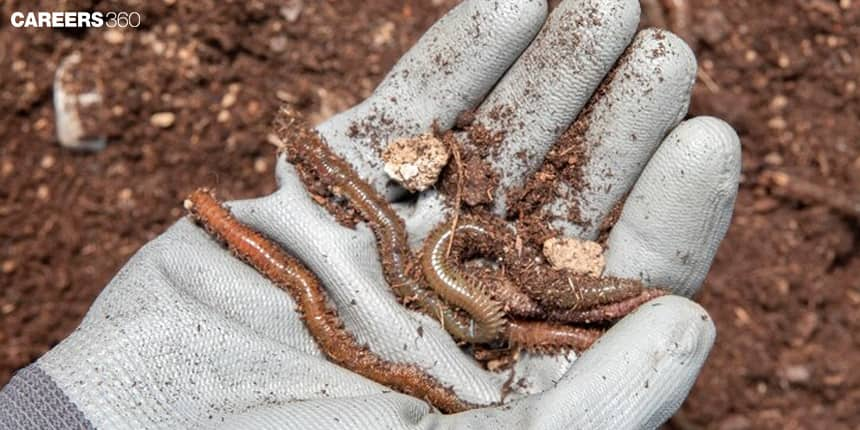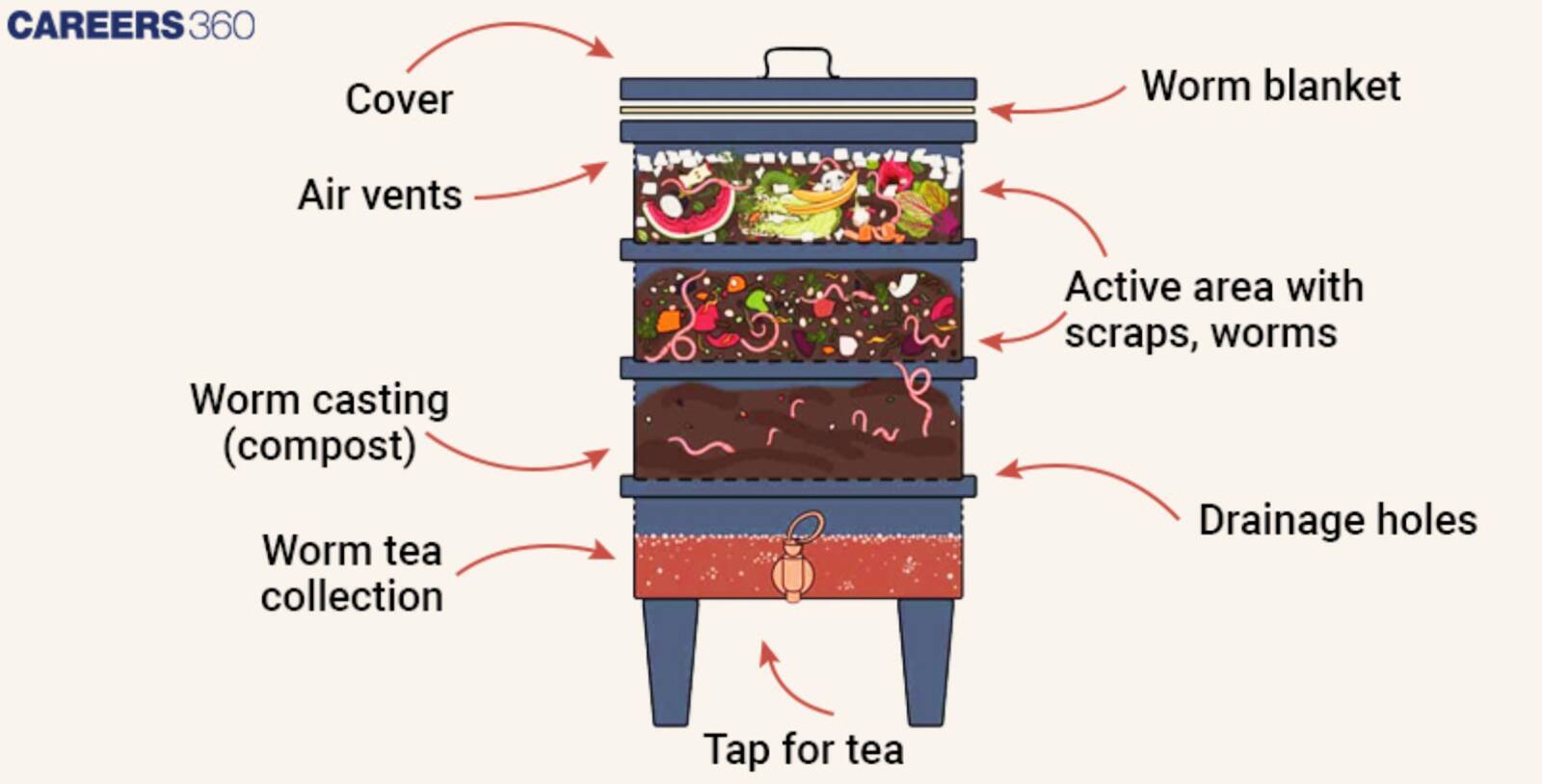Vermicomposting: Definition, Meaning, Methods, Benefits
Vermicompost is an organic fertilizer made by the vermicomposting process, where earthworms break down organic waste into nutrient-rich compost, also called vermicompost khad. In vermicompost preparation, a vermicompost pit or bed is set up with organic waste, and worms are added to decompose it over time. This vermicomposting method gives the soil essential nutrients promotes plant growth and reduces the need for chemical fertilizers. Advantages of vermicomposting include improved soil fertility and sustainability, and it’s easy to learn how to make vermicompost at home. This is an important topic of biology as it is covered in some of the major units.
NEET 2025: Mock Test Series | Syllabus | High Scoring Topics | PYQs
NEET Important PYQ's Subject wise: Physics | Chemistry | Biology
New: Meet Careers360 B.Tech/NEET Experts in your City | Book your Seat now
- Definition of Vermicomposting
- Vermicompost Preparation
- Applications And Benefits

Definition of Vermicomposting
Vermicomposting is a bio-recycle technique of recycling waste organic materials by using earthworms to break them down into compost. In ancient periods, it has been practised that earthworms were used to compost waste and it was in the 20th century that it received scientific attention and consideration as a proper method of sorting waste.
Vermicomposting is important due to its numerous environmental benefits. Some of them are discussed below:
It helps to minimise the amount of waste materials that are dumped into landfill sites.
Helps in preparing quality compost that improves the quality of soils and hence the growth of crops, and the promotion of sustainable methods of farming.
Vermicomposting which processes organic waste to produce compost could be a part of the circular economy.
Also Read
Vermicompost Preparation
Vermicompost preparation is a technique of composting wastes involving different kinds of earthworms most commonly red worms (Eisenia fetida) or California red worms (Eisenia hortensis). They feed on organic matter and emit feces which are forms of castings that are so useful in the improvement of soil health.
Steps of vermicompost preparation
Vermicast: Well-rotted compost, night soil, worm dung, manuscript, and worm castings are regarded as a natural fertilizer.
Bedding: The substrate, in which earthworms are situated – moistened newspaper, cardboard or peat moss that also serves as the earthworms’ food to begin with.
Feedstock: The types of household waste owned and included in the vermicompost bin, for example, vegetable scraps, peel of fruits, coffee grounds, and egg shells.
Worm Bin: An enclosure for the worms and wastes at the time of composting that facilitates the supply of correct aeration, moisture, and drainage.
Cocoon: The cocoon created by earthworms is a termite-like covering of the eggs for the developing young which will hatch into small earthworms and go on with the composting business.

Suitable Food Waste
Thus, for effective and efficient verm composting, offer your earthworms appropriate food waste that can easily be processed by the worms. Ideal food scraps include:
Fruit and Vegetable Scraps: An example here is peels, cores, and any other residual parts of fruits and vegetables. Citrus should be limited in serving because they contain high acidity.
Coffee Grounds: A preferred nitrogen source which incorporates worms. Other materials that can be added are coffee filters.
Eggshells: These crushed eggs act as a source of calcium to the flies and at the same time help to regulate the acidity of the bin.
Unsuitable Materials for Vermicomposting
Certain materials should be avoided in vermicomposting systems as they can harm the worms or create undesirable conditions:
Meat: Meats cause the attraction of pests and the development of bad odours due to the process of decomposition.
Dairy: Meat & Dairy products Smell bad and are not well processed by worms Therefore, these products contribute to the production of bad smell.
Oily Foods: Oily and fats-rich diets take time to degrade especially when the worms’ environment is moist and greasy, which is unhealthy for their body.
Applications And Benefits
Enhancing Soil Fertility: Vermicompost enhances the soil's nutrient quality by supplementing it with nutrient necessities for example nitrogen, phosphorus, potassium and micronutrients.
The organic matter in the vermicompost releases the nutrients slowly in the soil hence improving soil structure and microbial activities which leads to healthy soil for plant use.
Improving Plant Growth and Yield: Innovatively, germination rates and growth are proven to be enhanced if grown in soil that has been fortified with the aid of vermicompost.
With enhanced substrate aeration and water infiltration, this means improved root proliferation and nutrient absorption for healthier, higher-yielding crops of better quality.
Environmental Impact
Waste Reduction: Vermicomposting thus helps to get rid of organic waste thus minimising methane production and greenhouse gases from decomposing waste within the landfill. It converts organic waste into usable compost to recycle the nutrient cycle properly.
Also Read
Frequently Asked Questions (FAQs)
Vermicomposting is the process of using earthworms to break down biodegradable materials like fruit and vegetable waste, tea leaves, coffee grounds and papers, to produce manure. This process enhances the physical status of the soil as well as its fertility.
Thus, red wigglers (Eisenia fetida) and Black Head Composting Worms (Lumbricus rubellus) are preferable for composting because of their efficiency in consuming organic matter and because they are compost-specific.
We can feed our composting worms fruit and vegetable peels, coffee grounds, tea leaves, and eggshells to feed on. It is not recommended to consume meat, dairy, oily foods, or large amounts of citrus fruits.
Have the right level of wetness (like that of a wet sponge), and temperatures should lie between 55 and 77 degrees Fahrenheit (13 -25 degrees Celsius), proper aeration should also be achieved by the frequent turning of the bedding. Do not over-feed the pet and ensure you check for pests and any form of odour to ensure proper sanitation.
The best time to harvest verm compost is when it is dark in colour, crumbles easily and has no bad smell; this is normally after several months. You can harvest them by lading worms to one side of the bin while the compost is ejected on the other side of the bin, or mechanical solutions like screens that help you to separate worms from compost. After harvesting the vermicompost then it should be kept up in a properly conditioned area where it has to be maintained dry in a shaded area for usage like in gardening or farming.
Also Read
29 Nov'24 12:52 PM
26 Nov'24 04:23 PM
26 Nov'24 04:19 PM